by Larry Williams | Apr 29, 2014
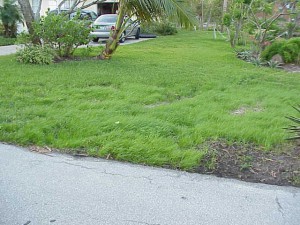
Kentucky bluegrass, Fescuegrass & ryegrass (annual ryegrass pictured) can be seeded to provide a temporary winter lawn but will not provide a permanent lawn in Florida due to our hot, wet summers. Photo Credit: Dan Culbert, UF/IFAS
If it sounds too good to be true, it probably is. This phrase offers sound advice for the person looking for the “perfect” lawn grass.
It’s common to see advertisements for the perfect lawn grass. You should be skeptical when reading advertisements that proclaim an amazing grass that produces a lush, green lawn with very little care. Question advertisements for grass seed mixtures that grow from Alaska to Florida. Beware of advertisements that do not include a specific name for the lawn grass being sold. Don’t believe advertisements that claim their grass even grows in impossible spots.
A number of years ago, I called a company that was advertising a grass seed mixture in hopes of finding out specifically what grass seeds were in this “too-good-to-be-true” mixture. I was told the seed mixture included Kentucky bluegrass, creeping red fescue and annual ryegrass. This information was not included in the advertisement. And it claimed that it would produce an attractive lawn for Florida.
In Florida, ryegrass, fescuegrass and Kentucky bluegrass will produce a green lawn during winter and early spring. However, as temperatures warm in late spring and summer, these grasses will die. All three are cool-season grasses that will not tolerate our hot, humid summer weather. They will not produce a permanent lawn in our area.
Basically there are seven types of grasses from which to choose when considering planting a lawn in Florida. Centipede and St. Augustine are the most commonly planted in our area. Bahia, bermuda, carpet, seashore paspalum and zoysia are used less often. All of these grasses have advantages and disadvantages, which should be looked at and understood before choosing a grass for your lawn.
With time, most people in our area will become frustrated with their lawn. As a result, North Florida is a great area to market a too-good-to-be-true lawn grass. It’s difficult to grow a lawn here. All of our lawn grasses are native to other parts of the world – they did not exist in our native ecosystem. Expectations for a Florida lawn are too high. Because of these factors, many people are looking for that too-good-to-be-true grass.
Be cautious before spending time and money on one of those “perfect” lawn grasses.
Contact the University of Florida Extension Office in your County or visit the following website for reliable information on lawn grass selection and maintenance for Florida. hort.ufl.edu/yourfloridalawn
by Les Harrison | Apr 8, 2014
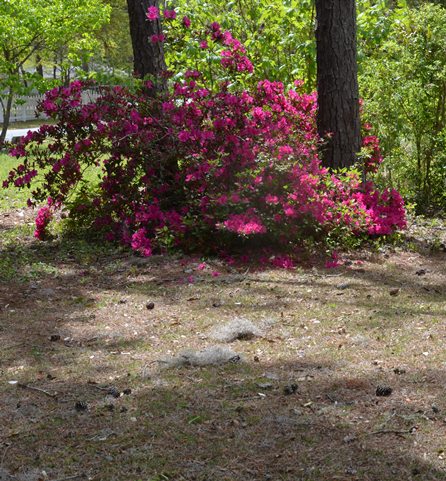
While the azaleas may be blooming, most north Florida Lawns still need some work to be ready for the growing season.
Spring is officially here, so this means it is time to get the lawn in shape for another growing season in north Florida. The first step is to develop an action plan which sets the path to achieving turf success.
A good starting point is mowing the lawn to get any leaves removed and trim any weeds which have emerged. Empty the bagged clipping in a compost pile for later use.
Shaded areas under trees must be treated differently since grass will not grow in those areas. Just leave the natural tree leaf mulch there and add additional mulch as needed.
If there are marginally shaded areas where turf is preferred, spring is a good time to plant some grass plugs. All southern turf grasses prefer full sun, but a few St. Augustine cultivars such as ‘Seville’, ‘Delmar’, and ‘Captiva’ will tolerate some shade.
Trying some plugs of ‘Seville’ St. Augustine is a low-cost way of determining if there is enough sunlight to grow grass. The plugs are available at local garden centers.
If the plugs don’t take hold and spread, then there is not enough sunlight. Use groundcovers, mulches, or other plantings in these shaded areas.
Before mowing, use a ruler to set the cutting level. Try to never remove more than one-third the length of the grass blade at any one mowing.
Sharpen the mower blades after every four to eight hours of mowing so a ragged cut is avoided. Maintain St. Augustine grass at about three inches tall and centipede at about one and one-half inches.
Most of the weeds currently in panhandle Florida lawns are winter annuals. They are flowering and will soon go to seed, then die as the weather gets hotter.
It is difficult to kill these winter annuals at this mature stage, so applying herbicide now is pointless. The best option is to keep the weeds mown so they do not produce as many seed and reemerge next year. Also, apply a pre-emergent herbicide in October 2014 to minimize 2015’s spring weeds.
Now is the time to put out a pre-emergent herbicide for some of the summer weeds, particularly chamberbitter.
Unless a soil test indicates a need for phosphorus, the best fertilizers to use on lawns will be missing this nutrient. The commonly available 15-0-15 fertilizers should also have half of the nitrogen (7.5%) in a slow-release form.
Many local retailers have these 15-0-15 fertilizers with and without herbicide. Generally speaking apply the 15-0-15 fertilizer without herbicide. Below is a table of recommended fertilizer application rates based on typical lawn square footage.
Table 2. Recommended application rates for turfgrass fertilizers to Florida lawns: 15–30 percent slow-release nitrogen. From Publication #ENH979
| Use this table to match the size of your lawn to the percentage of nitrogen (N) in your fertilizer to find the amount of fertilizer you need to apply. If you have a bahiagrass lawn, apply this amount of fertilizer about four times a year no matter where you live in the state. For centipedegrass, apply about twice a year in north Florida . For St. Augustinegrass or zoysiagrass, apply about four to six times a year in north Florida. UF/IFAS recommends soil testing for phosphorus content before any P fertilizer is applied. |
| |
6% N |
10% N |
12% N |
15% N |
16% N |
23% N |
27% N |
| 1,000 ft2 |
8.25 lbs |
5 lbs |
4.25 lbs |
3.25 lbs |
3 lbs |
2.25 lbs |
2 lbs |
| 1,100 ft2 |
9.25 lbs |
5.5 lbs |
4.75 lbs |
3.5 lbs |
3.5 lbs |
2.5 lbs |
2 lbs |
| 1,200 ft2 |
10 lbs |
6 lbs |
5.25 lbs |
4 lbs |
3.75 lbs |
2.5 lbs |
2.25 lbs |
| 1,300 ft2 |
11 lbs |
6.5 lbs |
5.75 lbs |
4.25 lbs |
4 lbs |
2.75 lbs |
2.5 lbs |
| 1,400 ft2 |
11.75 lbs |
7 lbs |
6.25 lbs |
4.5 lbs |
4.5 lbs |
3 lbs |
2.5 lbs |
| 1,500 ft2 |
12.5 lbs |
7.5 lbs |
6.75 lbs |
5 lbs |
4.75 lbs |
3.25 lbs |
2.75 lbs |
| 2,000 ft2 |
16.75 lbs |
10 lbs |
8.5 lbs |
6.5 lbs |
6 lbs |
4.5 lbs |
4 lbs |
| 2,500 ft2 |
20.75 lbs |
12.5 lbs |
10.5 lbs |
8.25 lbs |
7.75 lbs |
5.5 lbs |
4.75 lbs |
| 3,000 ft2 |
25 lbs |
15 lbs |
12.75 lbs |
9.75 lbs |
9 lbs |
6.5 lbs |
6 lbs |
| 3,500 ft2 |
29 lbs |
17.5 lbs |
15 lbs |
11.5 lbs |
10.75 lbs |
7.75 lbs |
6.75 lbs |
| 4,000 ft2 |
33 lbs |
20 lbs |
17 lbs |
13 lbs |
12 lbs |
9 lbs |
8 lbs |
| 4,500 ft2 |
37 lbs |
22.5 lbs |
19 lbs |
14.75 lbs |
13.75 lbs |
10 lbs |
8.75 lbs |
| 5,000 ft2 |
41 lbs |
25 lbs |
21.25 lbs |
16.5 lbs |
15.5 lbs |
11 lbs |
9.5 lbs |
| *These recommendations assume use of a properly calibrated spreader. See www.yourfloridalawn.ifas.ufl.edu for instructions on calibrating your spreader. |
If the soil is too compacted, too wet, too dry, or has nematodes, certain weeds may grow better in those conditions than does your lawn grass. Take the time to identify why the grass is not growing well.
Rain has provided enough water so far this spring, but this could change at any moment. However, do not water unless it is needed.
Only water when about thirty percent of the lawn wilts, turning dull grayish color as the leaf blades roll inward. At that time water deeply, applying about one-half inch of water as measured in cans placed in the sprinkler pattern.
To learn more about proper turf care in north Florida contact your local UF/IFAS County Extension Office.
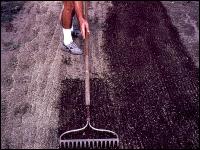
by Larry Williams | Apr 1, 2014
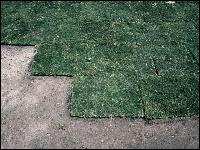
Sodding Lawn Photo Credit: UF/IFAS

Hand Raking Lawn Area Photo Credit: UF/IFAS
Cutting corners during lawn renovation usually results in poor turf establishment and long-term lawn maintenance problems.
Occasionally it is necessary to renovate a lawn or replant sections of a lawn. When replanting a lawn, it is best to not cut corners – you’ll usually pay for it in the long run. One of the most important factors is to prepare a good planting bed when renovating a lawn.
It doesn’t matter if you intend to re-sod, re-sprig or reseed; you need a level, loose and well-drained planting site for your lawn. A level lawn is much easier to mow. The loose soil allows for quicker root and runner establishment. Also, a well-drained site allows excess water to drain, preventing some disease problems.
One option is to spray the existing weeds and grass with a glyphosate herbicide such as Roundup. Allow the proper number of days for the weeds and grass to turn yellow (usually seven to 10 days).
Next, thoroughly till the area to a depth of 6 to 8 inches to loosen the soil.
Finally, level and smooth the planting bed, raking and then dragging (if needed) the bed. This can be done with a hand-rake and a hand-pulled drag such as a piece of chain-link fence on smaller areas. A tractor with rake and a grading box can be used on larger areas. A second option is to rent a sod cutter or remove the existing grass with a shovel before tilling and grading the site.
But whatever you do, don’t just lay new sod or broadcast grass seeds over a compacted, uneven, old lawn. There are just too many possibilities of having long-term and costly lawn problems as a result.
For additional information on establishing a Florida lawn, contact your local University of Florida Extension Office or visit http://hort.ufl.edu/yourfloridalawn.
by Julie McConnell | Sep 9, 2013
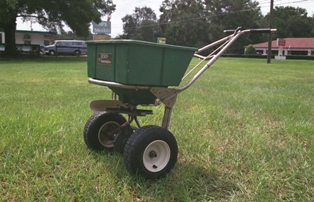
Fertilizer Spreader: Image Courtesy UF / IFAS Extension FYN Program
Although temperatures are still hovering around 90° F, the last fall fertilization date is approaching quickly. Mid-September is the
deadline for applying fertilizer to warm season turf-grasses and landscape ornamental plants for the year. Why is September 15 the cutoff date? In North Florida, our estimated first frost date is November 15. When fertilizer is applied the nutrients encourage new growth that typically takes about 6-8 weeks to become “hardened off” and able to tolerate low or freezing temperatures. So, simply backtracking on the calendar gives you an idea of when to make the last application of fertilizer (if needed).
If September 15 is at the end of our warm season feeding schedule, the next question should be “when should I fertilize in the spring?” Although Northwest Florida’s average last frost date is listed as March 15, UF/IFAS Turf Specialist Dr. Bryan Unruh does not recommend fertilizing before April 15 in the panhandle. There are two main reasons for this later date. One is that the March 15 last frost date is an estimate, many times cold weather follows a warming trend in late winter/early spring. During April of this year warm weather was followed by cool temperatures with cold winds that caused landscape plant damage. If fertilizer was applied before this weather arrived, some cold damage may have been evident this spring in affected landscapes. The second reason is that if fertilizer is applied to turf or plants that are not actively growing and using those nutrients, it may leach out of our sandy soils. Nutrients do not wait for plants to use them; they can be washed out and become a source of nonpoint source pollution.
To read more tips on fertilizing visit EDIS ENH1174 “The Lawn Fertilizer Toolbox”
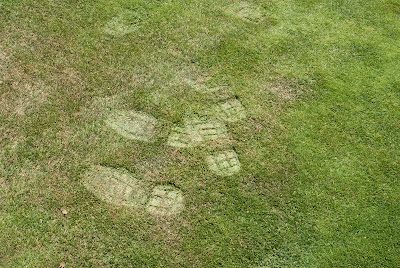
by Taylor Vandiver | Jul 15, 2013
Turfgrass, like all plants, requires water for growth and survival. With the weather we’ve been having lately, watering your lawn is probably the last thing on your mind.
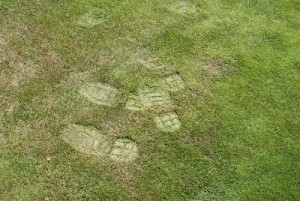
Footprints in turfgrass are a common symptom of drought stress. They are the result of a loss in turgor pressure, due to lack of water, in plant tissue.
However, without sufficient rainfall, water to home lawns will need to be supplemented with irrigation. The most efficient way to irrigate or water your lawn is to apply water only when the lawn starts to show signs of drought stress from lack of moisture.
A few signs associated with drought stress include the changing of turfgrass color from green to a bluish-gray, or white cast. Another sign could be “footprints” on the lawn. If walking across a lawn late in the afternoon causes footprints to be left behind, the lawn may need watering. When feet compress the leaf blades of the turfgrass, the low water levels in the plant tissue prevent the leaf blades from recovering, or “springing” back up, after being pushed down. If the footprints remain for an extended period of time, water the lawn to prevent the turfgrass from turning brown and becoming dormant. The visual condition of the turfgrass can also be used to evaluate drought stress. Turfgrass blades respond to drought stress by folding, rolling, and/or wilting.
A recommended application of ½ to ¾ inch of water can be applied when your turfgrass begins to show the drought stress symptoms discussed previously. Once this amount of water is applied, do not apply again until drought is noticeable. If it rains, like it has been lately, hold off on irrigating until visible drought stress symptoms appear.
Irrigation frequency can vary based on grass species, rainfall amounts, soil type and amount of compaction, shade presence, location, etc. There is a fine line between under and over watering a lawn. Over watering can cause problems such as poor root growth and susceptibility to disease. Over watering can also increase the presence of weed species. When watering, avoid applying water to the point of runoff. Allow the water to soak into the lawn and soil. The optimal time of day to water lawn grass is during the early morning hours. If irrigation is done during the day that water is being lost to higher evaporation rates. Watering in late afternoon or late morning may be detrimental if it extends the time the lawn is naturally wet from dew. This extended “dew period” may increase disease presence in turf.
Automated irrigation systems are convenient, but can have flaws. Always check to make sure your system is working properly and is applying the correct amount of water. However, if significant rainfall has fallen for the week, the automated timed irrigation systems can be turned off so water is not wasted.
Once turf has been watered, it should not be watered again until similar drought stress symptoms are observed. It is never suggested to water your lawn every day, unless it is in the establishment phase or renovations are occuring. Proper watering techniques are key to creating a happy and healthy lawn.







